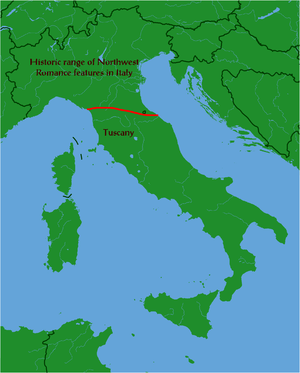Isogloss
A isogloss ( Art word on the type of isobar or isotherm , from ancient Greek ἴσος isos , German , equal ' and Greek γλῶσσα GLOSSA , tongue, language') is the line in a language Atlas , the boundary between two versions of a linguistic feature highlighted. Where several isoglosses run on one line, one speaks of an isogloss bundle .
A linguistic feature is, for example, the pronunciation of a consonant or vowel ( China: [ ˈçiːnaː ], [ ˈʃiːnaː ] or [ ˈkiːnaː ]), a grammatical form, the use and meaning of a word or the like. Such linguistic features are also known as linguistic variables . Important isoglosses of the German dialects are the Benrath line , the Speyer line and other lines of the Rhenish fan . Other isogloss lines are the La Spezia Rimini line in Italy or the Joret line in France.
In newer language atlases, different colors are used for the different characteristics instead of isoglosses. The isogloss or the “isogloss bundle” is then the edge of a color zone. If a certain characteristic expression appears only in one place or in a very small area or in isolated cases, it is marked with a symbol , a letter or a number .
Word creation "isogloss"
Formed analogously to the geographical term isohypse ( contour line ) and the meteorological term isobars (line of the same air pressure), the linguistic term "isogloss" is linguistically imprecise: isohypse and isobars as connections of points with the same measured values deserve the word component iso- from ancient Greek isos (“Equal”) and are primarily not boundaries, but rather lie in a continuum, since across their course the measured values steadily increase in one direction and steadily decrease in the other. The so-called isoglosses, on the other hand, are lines of linguistic inequality (anisoglossy) between (in each section two) areas within which there is linguistic equality (isoglossy) as real borders. So they should actually be called "anisoglosses". For comparison: In medicine, anisocoria describes a difference in pupillary width between the right and left eye.

